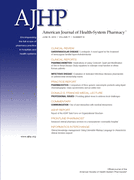-
Views
-
Cite
Cite
P. Brandon Bookstaver, Amanda C. Capino, Nicole K. Bookstaver, A pharmacy concierge service to optimize fidaxomicin therapy, American Journal of Health-System Pharmacy, Volume 71, Issue 12, 15 June 2014, Pages 986–987, https://doi.org/10.2146/ajhp140013
Close - Share Icon Share
Extract
The incidence of Clostridium difficile infections (CDIs) has increased in recent years, with up to 700,000 cases estimated annually.1 Given the frequency of host risk factors and the durability of this spore-forming pathogen, recurrence rates approximating 25% are expected.1,2 Because of the challenges in effectively treating recurrent CDI, prevention of recurrence has become a priority through infection-control practices, reduction of modifiable risk factors, and optimal initial treatment. In 2011, fidaxomicin was FDA approved in adults for the treatment of C. difficile-associated diarrhea at 200 mg orally twice daily for 10 days.3 When compared with oral vancomycin, fidaxomicin was shown to be noninferior for clinical cure and superior for sustained clinical response, primarily due to a reduction in disease recurrence.4,5
There are several potential barriers to fidaxomicin use, including the costs to both the patient and the institution.2,6 Although reduced recurrence could seemingly provide both financial and clinical benefits, the overall cost-effectiveness remains unclear.6,–8 Reimbursement mechanisms such as Medicare’s New Technology Add-On Payment Program (NTAP) for fidaxomicin have been established to help reduce institutional cost, reimbursing institutions up to $868 for eligible cases.9 The cost-effectiveness of fidaxomicin is likely dependent on targeted use in specific patient populations.2,6 For patients discharged from the hospital and needing continued treatment, lack of fidaxomicin availability at community pharmacies could lead to an interruption in therapy, an increased risk of recurrence, and subsequent readmission. One strategy to overcome these barriers is a pharmacy-driven transition-of-care intervention at the point of discharge, known as a pharmacy concierge service at our institution.






Comments